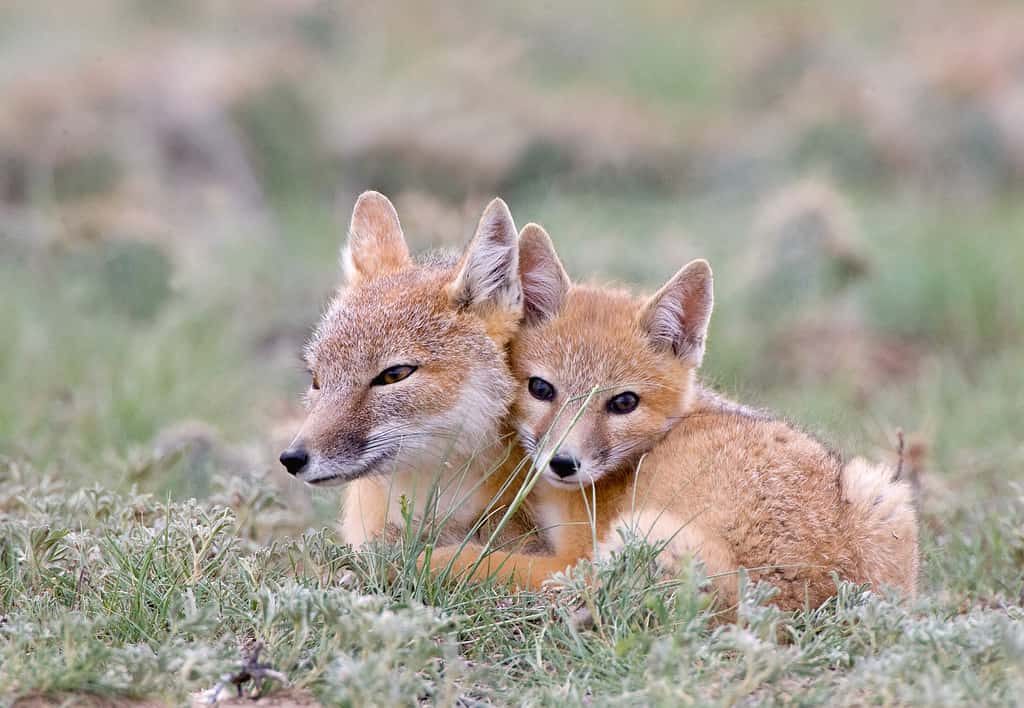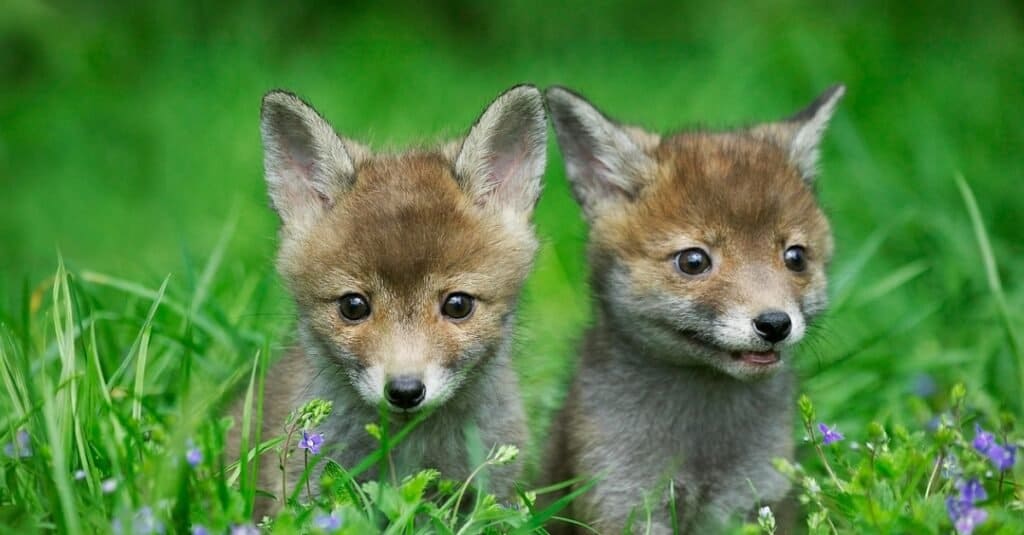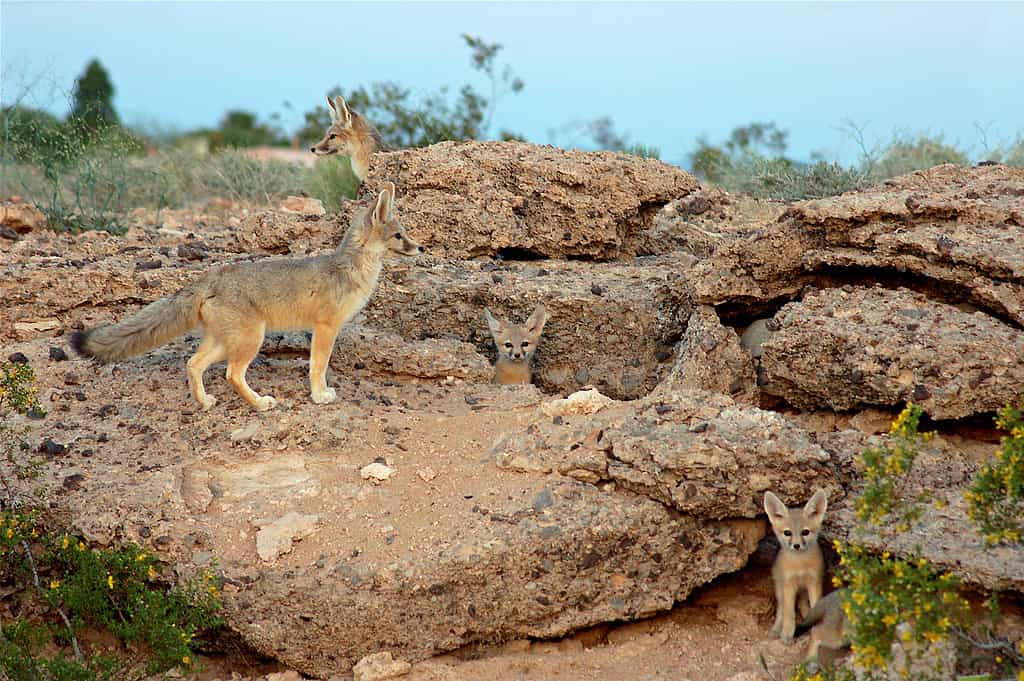What animal in Texas likes to make new friends? Red foxes.
Red foxes live in social groups, but we know little about their behavior and relationships. Recently, scientists used cameras to study urban red foxes. What did they find?
The cameras showed that wild foxes usually run into new foxes when looking for food. Sometimes these encounters spawn a new friendship. Other times, the newly acquainted foxes become enemies.
A fox friendship can be a fickle thing. The foxes’ social structure changes depending on the season, like when babies were born. When babies come around, mom and dad foxes show very little interest in making new friends or keeping ties with old ones.
There’s a lot more to this species than most people think. Foxes are complex creatures, and we’re here to help you learn all about them. What type of foxes live in Texas, and where can you find them? Read on to learn all about this incredible species.
Red Fox

Red foxes are known for traveling the same route over and over.
©Ondrej Prosicky/Shutterstock.com
Texas is home to the red, gray, kit, and swift foxes. Red and gray foxes are the two most common types of foxes in Texas.
Even though they’re mostly nocturnal, red foxes have crepuscular tendencies. They like to move around just as the sun is beginning to come up. The break of dawn can be a prime time to hunt. Red foxes hunt small rodents and rabbits and forage for wild fruits and berries. As opportunistic feeders, they’ll eat almost anything they can get their paws on.
A red fox family consists of a male and a female (vixen), and they’re young. The adults will stay in the same home range long after their kits have grown and gone off on their own. They remain in the same area for most of their life, as long as there’s enough. Red foxes are known for traveling the same route over and over, creating easy-to-navigate fox trails.
Kit Fox

The kit fox can be found primarily in southwest Texas.
©Swaroop Pixs/Shutterstock.com
You can also see the kit fox while you’re in Texas. These cute animals live primarily in southwest Texas. Even though they look dainty, kit foxes are experts at surviving the hot, harsh desert habitat. They might look delicate, but they’re really tough creatures!
Unfortunately, a long time ago, in an attempt to control wolf and coyote populations, poison was put out throughout Texas. Some of the kit foxes got into the poison, and their population numbers suffered. They almost disappeared from the state entirely! Thankfully, they’ve made it come back, creating adorable wildlife sightings throughout the state.
The kit fox is about the same size as a house cat. They have delicate ears that help them control their body temperature and listen to everything around them. These foxes have excellent hearing. Their gray coat helps them blend into the environment, and slim, short legs help them quickly chase after prey.
As they run after a rabbit, the fur on their paw pads protects them from the scolding sand. Instead of drinking water, these foxes prefer hydration from their food. They’re most active at night and during the day and can be found lazily hanging out in burrowing systems. The burrowing systems help keep them cool and protect them from predators like coyotes and golden eagles.
Swift Fox

Swift foxes are smaller then other foxes, weighing 5 pounds on average.
©Rob Palmer Photography/Shutterstock.com
Another Texas fox that’s the size of a cat is the swift fox. During the winter, the swift fox has gray fur on its back and tail and tan fur on its side. Its throat and underbelly are a light white or tan color. You can tell these foxes apart from the others by their black-tipped tails and black patches on their muzzle. Red foxes have white tipped tails, and gray foxes have a black stripe down their tail.
Swift foxes are much tinier than other foxes. On average, they weigh 5 pounds. In comparison, the two most common foxes in Texas, the red and gray fox, way between 6 to 11 pounds. A long time ago, these foxes lived in the high plains region of Texas, all the way to Canada. Then, their population began dwindling, and sightings became more rare.
For a decade, nobody saw any swift foxes throughout Texas. But that all changed in 1996 when a biologist from confirmed a swift fox sighting. It was the first time this species had been seen in 10 years! Researchers are still working to find exactly where swift foxes live in Texas.
So far, their numbers are most prevalent in the northwest corner of the panhandle. These tiny foxes like to hang out in flat prairies with short grass. In States like Oklahoma, they’ve been found in fields, fences, and anywhere they can stay warm. Like other foxes, the swift fox stays in an underground den during the day. As the night approaches, they come out to hunt.
Gray Foxes

Gray foxes are excellent tree climbers.
©Danita Delimont/Shutterstock.com
The gray fox is one of the most common fox species in Texas. They’re a medium sized animal that usually weighs between 8 and 12 pounds. They have gray fur with red areas on their belly and legs, a white throat, and a famous bushy tail.
Are foxes dogs? All fox species belong to the canidae family, the same family as wolves and dogs. The gray fox has a lot of dog-like tendencies, especially when they’re seen playing around. But one of the things that makes them very different from dogs is their ability to climb trees.
Gray foxes are excellent tree climbers. They can scale a tree in seconds to evade a threat. These resourceful creatures don’t just use the tree’s height; they use the trunk too. One of a gray fox’s favorite homes is a hollow tree stump. They find it super cozy.
Gray Fox Moms Are Tough
Gray fox moms are tough. But only because they care. When it’s time for the babies to care for themselves, they don’t waste time chasing them out of the cozy den. They do this out of love to make sure their babies grow up to be big and strong and live in different places. By spreading out, they can ensure there’s enough food to go around.
Gray fox’s moms also stop being nice to the dads after the babies grow up. Sometimes they get back together and have more kids in December, but otherwise, they leave each other alone. It’s a rocky relationship, to say the least.
These foxes value their alone time, and when they’re not mating or raising kits, they lead a solitary life. Gray foxes will spend many winters with only themselves to pass the time. On average, gray foxes live 6 to 10 years in the wild.
Where to Find Foxes in Texas

The best time to see a baby fox in Texas is between March and May.
©iStock.com/slowmotiongli
Where can you find foxes in Texas? Foxes like to live in places where they can find plenty of cover. This includes the edges of forests, hilly landscapes, and for some species, areas with high grass. If you are around Arlington, Texas, you can use this Arlington wildlife sighting map. It shows where the foxes are hanging out.
Since foxes are mostly active at night, your best chances for spotting one are during twilight hours. If you have night vision goggles, you can also try to see one in the middle of the night. On rare occasions, foxes will hunt during the day. But they usually only venture out into the sunlight when hungry. If you’re in an area that doesn’t have a lot of human activity, and the fox is hungry, there’s a good chance they’ll go on the hunt during the day.
If you want to see a baby fox, you want to look for them between March and May. Foxes usually mate in January or February, with their young appearing at the arrival of spring. Young foxes can sometimes be seen playing during the day. Sometimes their parents are around; other times, they’re off getting food.
Red Foxes Sightings: City and Countryside
For a red fox, moving day comes often. They’ll relocate if they’re not 100% happy with their home range. They’ll do this again and again until they find the perfect spot. And even after finding the perfect spot, that doesn’t mean they have a permanent home. If something changes and the red fox isn’t satisfied, they’ll move again!
This fox study observed how and why young red foxes move. They wanted to see how they move around from the city and countryside in the Midwest region of the United States. Researchers recorded 96 times when a young fox moved to a new place. They also recorded 66 times when a young fox stayed in the same place. What were scientists able to learn from their observations?
Red foxes are picky about their neighbors. One of the key factors that would influence whether or not the young red fox moved from their home or stayed had to do with the surrounding wildlife. They might be prone to move if they had to share their home area with other fox families. But sometimes they don’t mind sharing.
Whether they stay or go depends on how they get along with their family members. Foxes are happy to share space when they get along with their family members. But once there’s tension, they’re quick to flee the scene.
What Is the Tiny Fox in Texas?
Is it a swift fox or a kit fox? Some people think the kit fox and swift fox are the same animals. Scientists have done studies to try to figure out if they’re different species. But nobody can seem to agree on the conclusions! The jury is still out on whether or not the tiny fox in Texas is the kit fox, swift fox, or if they’re the same species.
Kit foxes prefer the rocky areas in Texas. The swift fox lives in grassy areas in the northern part of the state. The two animals may keep a distance from each other because of their habitat preferences. Some naturalists theorize that if the foxes were able to, they would be more than happy to mate. In areas like the west of Lubbock and Odessa, there have been possible kit swift hybrid fox babies sighted.
Saving Texas’s Kit Fox

The kit fox is important to the Texan ecosystem because they eat insects and small rodents.
©iStock.com/Sherri Cassel
A while ago, Texas Parks and Wildlife team members noticed a problem. The swift fox population was declining at a rapid rate. And they knew if the swift fox was suffering, the kit foxes were probably suffering too. This began their journey to check on the status of the kit foxes, even though no one had ever done a survey to see how many live in Texas.
Matt Hewitt began using trail cameras to study the kit foxes. With his friends’ help, he could track the foxes in nine counties in Western Texas. The cameras were set up at 732 sites and left out for 2 weeks each time. And guess what? They found kit foxes present at 99 of the sites! Yay, foxes!
Researchers used these trail cam findings to predict other areas the kit foxes might be living in the trans-pecos region. They were happy to find that this species is thriving, and their population numbers are rising. These tiny foxes are important to the Texan ecosystem because they eat insects and small rodents. They help keep things in balance. The next time you’re in Texas, keep an eye open for these itty bitty foxes. And if you love tiny foxes, check out this one, the fennec fox. It’s not in Texas but it’s super tiny.
The further you go into the Trans-Pecos region, the more likely you find kit foxes. They like to live in high-elevation grasslands with flat open spaces. The models predict that many of the foxes live close to the border, but the trail cameras didn’t pick any up there. The study stopped at the town of Marfa; that’s where the center of the study took place.
This kit fox trail cam study was only a baseline study. It’ll be exciting to see future research to determine how the population is changing. For now, it doesn’t look like the kit foxes are leaving Texas anytime soon. They have a healthy habitat range now, and there’s still plenty of room for these cute creatures to expand their territory.
What To Do About Fox Dens in Texas
Texans sometimes find themselves the unsuspecting host of a fox family. What should you do if a fox digs a den on your property? Sometimes foxes dig under porches, sheds, or decks, which can be a problem for homeowners. These curious creatures can also approach people if humans have fed them, which introduces a world of problems. So what should you do if a fox is making an appearance on your property?
Animal lovers understand, disturbing a fox family isn’t something you should do if it’s avoidable. If a fox family is living in a spot, it’s always wonderful if you can wait for the kits to be old enough to move out. This would be the ideal situation, and it doesn’t take long. The mom fox pushes the babies out as soon as they’re big enough to care for themselves. She doesn’t waste any time kicking them out of the den.
What if you need the foxes to leave sooner? You can use humane tactics to make them uncomfortable with noise or smells they don’t like. Whatever you do, ensure the kits have fully vacated the area before using any tactics. You can also check with your neighbors and local wildlife officials. They’ll have the most up-to-date advice, and we’ll probably be able to point you in the right direction.
Foxes Aren’t Scary, But Be Careful
How can you stay safe around foxes in Texas? Just give them their space. Seeing a fox in the wild is an exciting experience, and it usually doesn’t last very long. The moment they notice a human is watching, they’re quick to flee the scene.
Remember the tail tip trick if you see a fox in Texas. Gray foxes usually have a black-tipped tail, and red foxes have a white-tipped tail. If the tail is extra big and bushy, there’s a good chance you’re looking at a red fox. Happy wildlife sightings!
The photo featured at the top of this post is © sunsinger/Shutterstock.com
Thank you for reading! Have some feedback for us? Contact the AZ Animals editorial team.






